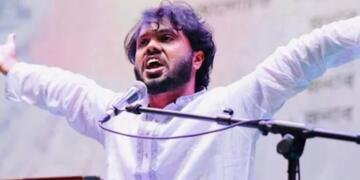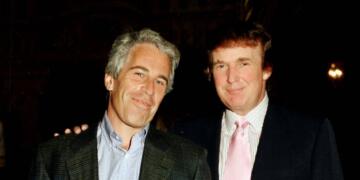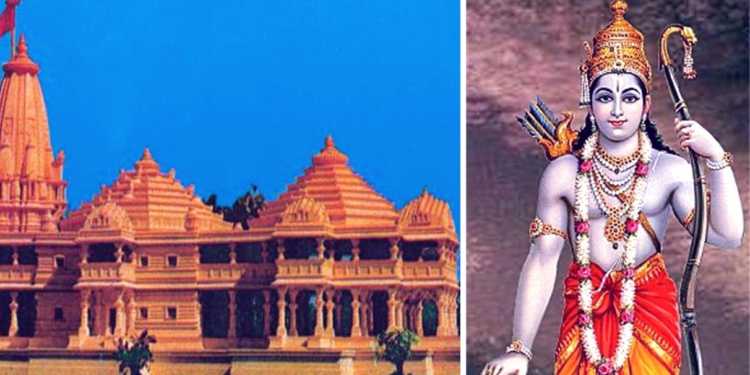We are really thankful to Meenakshi Jain for the wonderful insights in her books “Rama and Ayodhya” & “The Battle for Rama: Case of the Temple at Ayodhya”. Without those elaborate details the article wouldn’t have been complete. We are also thankful to Aryan Books International (http://www.aryanbooks.com/) for their support and guidance
We would request the readers to read both the books as it’s an ocean of knowledge w.r.t. Ramjanmabhumi Movement
Jai Shri Ram
श्रीराम राम रामेति रमे रामे मनोरमे । (1)
सहस्रनाम तत्तुल्यं रामनाम वरानने ॥ (2)
(1. By meditating on “Rama Rama Rama” (the Name of Rama), my Mind gets absorbed in the Divine Consciousness of Rama, which is Transcendental,
2: The Name of Rama is as Great as the Thousand Names of Bhagwan (Vishnu Sahasranama))
Intro
Belief in Hinduism and Nationalist sentiments complement each other in a big way and for Hindus, Ayodhya – the birth place of Maryada Purushottam Bhagwan Rama “7th Avatar of Bhagwan Vishnu” is of epic significance. It’s believed that taking a holy dip in Sarayu River washes away all sins and it’s a pathway to attain Moksha but apart from that Ayodhya also stands out in the imagination of Hindus, nationalists or otherwise as a place where Babur, the first Mughal built the Babri Masjid by demolishing the pre-existing Rama temple
Ever since lakhs of Hindus have attained martyrdom trying to liberate the birth place of Bhagwan Rama and attempting to undo the historical injustice by building a grand Ram Mandir in Ramjanmabhumi. According to the renowned Historian, Cunnigham, almost 1.5 Lakh Hindus led by Hindu King Raja Mahtab attained martyrdom while fighting the forces of Mir Baqi to save Ramjanmabhumi Mandir. Soon after this battle thousands of Hindus attained martyrdom led by Devideen Panday (Hindu leader) and Ranvijay Singh (King of Hanswar) fighting the same brutal Islamic army under the command of Mir Baqi. These incidents have been highlighted by many historians but there are many stories of struggle that remained buried in the sands of time.
Hindus didn’t just lose their lives during the Islamic rule, but also during the 7-decade-long Pseudo Secular reign.Kar Sevaks have routinely been killed. Almost 200,000 villages sent bricks, 300,000 pujas of the Ram Shilas were performed and an estimated 100 million people attended the various processions throughout the length and breadth of the nation that carried the sacred bricks to Ayodhya. But on morning of 2nd November 1990, Mulayam Singh Yadav re-enacted a Jallianwala Bagh, When state police mercilessly fired and killed Kar Sevaks in the most brutal way. As per BJP the number of casualties was around 168, but locals and eyewitnesses accounts say it ran into thousands. By killing Hindus, Mulayam Singh was able to form a formidable MY – Muslim-Yadav vote bank that made him a political force to reckon with in U.P. While the MSM only keeps on raking the issue of Babri demolition where not even a single life was lost, the horrors and catastrophes that unfolded on 2nd November 1990, can never be erased from memories of the people who were there.
The 500-year-old Ayodhya Ramjanmabhumi dispute continues to grip the national consciousness and has defined politics in independent India since its founding in 1947 best exemplified by the long drawn battle set in motion in Ayodhya to reclaim the Ramjanmabhumi. Let’s examine who does have the moral rights to the Ramjanmabhumi land. Let’s try to have a look on some aspects through the prism of “IDOL, PLACE as JURIDICAL ENTITY” and “Revenue Records and WAQF Board” as Archaeological, Literary, Sculptural and Epigraphic evidences. These prove the Hindu argument that “Mandir was demolished to build the mosque…”
Have we ever imagined whether there’s really a case for a Mosque and why Hindus have the ONLY Right to the Ramjanmabhumi?
IDOL & PLACE of WORSHIP of HINDUS ARE JURIDICAL ENTITY
Meenakshi Jain (in her book titled Rama & Ayodhya) mentions
“Hindu legal and sacred texts were clear that temple property could not be lost under any circumstances. According to Katyayana, temple property was never lost, even if enjoyed by strangers for hundreds of years (Kane III 1993 : 327-328). The Dharmashastras ensured that the rights of the deity were in perpetuity and could not be interfered with by a King (page 2541 para 2587 pages 2548-2550 para page 1827)”
IDOL: A Juridical Entity
The concept of conferring legal personality on a Hindu idol/ deity was first established by courts in British India in the nineteenth century (page 1875 para 1767). The Allahabad High Court described the extension of the concept of personality beyond the class of human beings as “one of the most noteworthy feats of the legal imagination”(page 1865 para 1751)
Britishers compared ancient Hindu law with the rules of the Church of England and appreciated it. West and Buhler, in their work Hindu Law, identified Hindu Religious Endowments, i.e., temples and idols, with corporate bodies and juridical persons as known in England (page 1877 para 1768)
The Supreme Court of India also had given numerous judgements based on this aspect i.e. believing this view (let’s look at a selective few judgements highlighted by Meenakshi Jain in her book)
1.) Ram Jankijee Deities vs. State of Bihar, The Supreme Court observed that
“Hindu Law recognizes a Hindu idol as a juridical subject being capable in law of holding property by reason of the Hindu Shastras following the status of a legal person in the same way as that of a natural person. It is not a particular image which is a juridical person but it is a particular bent of mind which consecrates the image… Images, according to Hindu authorities, are of two kinds : the first is known as Swayambhu or self-existent or self-revealed, while the other is Pratisthita or established… A Swayambhu or self-revealed image is a product of nature and it is Anadi or without any beginning…”(pages 1902-1904 para 1801)
Bishwanath & others vs. Sri Thakur Radha Ballabhiji
The Supreme Court upheld the right of a deity to file a suit for declaration of its title and possession thereof. The Court stated
Three legal concepts are well settled: 1) An idol of a Hindu temple is a juridical person 2) when there is a Shebait, ordinarily no other person oher than the Shebait can represent the idol; and 3) worshippers of an idol are its beneficiaries, though only in a spiritual sense… (page 1926 para 1824)
Poohari Fakir Sadavarthy vs. Commissioner
The Apex Court laid down the requisite conditions for a religious institution to be a “temple” It stated,
To constitute a temple, it is enough if it is a place of public religious worship and if the people believe in its religious efficacy irrespective of the fact whether there is an idol or a structure or other paraphernalia. It is enough if the devotees or the pilgrims feel that there is some super human power which they should worship and invoke its blessings (page 1927 para 1827)
PLACE: A Juridical Entity
Looking into objections raised by the counsels for Muslim parties that “How can a place be Juridical Entity”, The Allahabad High Court held that a deity could be in the form of an idol or in a natural form like stone, wood, earth, river, mountain etc.
In Ram Jankijee Deities & others, the Supreme Court had observed that a Swayambhu or self-revealed image was a product of nature and was Anadi, without beginning (pages 1970-1971 para 1880). The only prerequisite, in its view, was that in the case of a place, it must be ascertainable that it was held sacred by worshippers (page 1978 para 1898)
The Allahabad High Court upheld the concept of a place as a deity. The divinity of a place made it a Swayambhu deity, capable of worship by believers. This status was
“Non-destructible, permanent and can neither be altered nor otherwise be damaged or diminished or extinguished by an act of human beings. It is a perennial and continued status of the place concerned (page 1978 para 1900)”
SITE NOT SACRED IN ISLAM
There’s an altogether different belief with respect to Islamic Law on “Sanctioning of Mosque on an already occupied site of other religion”. Several historians appearing on behalf of the Sunni Waqf Board conceded in Court that Islamic law did not sanction a mosque on an already occupied site. Professor Shireen Moosvi, for instance, said
It is hue to say that if a place of worship of any religion is demolished, that will remain as such for that religion. It is correct to say that if a mosque is constructed by demolishing a temple, its status will not change and it will remain as a temple, nothing else and if a temple is constructed by demolishing a mosque, it will continue to be a mosque, nothing else. If it is proved that at the disputed site, there was a temple forcibly demolishing which a mosque was constructed then it will be considered to be a temple, nothing else (page 4863)
Apart from this Supreme Court in its judgement of Dr. M. Ismail Faruqui and others versus Union of India and other (1994) held that a mosque was not an essential part of the practice of the religion of Islam. It further states “A Muslim could offer namaz even on open ground. The Court observed that unless the right to worship at a particular place was itself an integral part of that right, i.e., the place was of a particular significance, its alienability could not be doubted (pages 4411-4412 para 4052)
The above judgements give a clarity why Hindus only have the moral rights on Ramjanmabhumi
REVENUE RECORDS & WAQF BOARD
(Reference: “The Battle for Rama: Case of the Temple at Ayodhya” by Meenakshi Jain 2017)
WHAT DOES LAND REVENUE RECORDS SAY
After examining the revenue records relating to village Ram Kot, Haveli Awadh, available at the District Record Office (Mahafaz Khana/Tehsil Office/Nazul Office) at Faizabad (comprising of revenue documents like survey, bandobast (settlement), kishtwar khasra, abadi, khewats, khasra khataunis and maps etc., from AD 1861 to 1990-91), Professor B.R. Grover revealed that from the time of the first Regular Settlement in 1861, the land was shown as Nazul (Government) and this had not been disputed or challenged by anyone
The first Regular Settlement Report of Kot Ram Chandra, appended by two maps, was the most comprehensive document relating to the Janmasthan complex comprising Ramjanmabhumi. In the revenue documents, the superior ownership of the land had been declared in the name of Sarkar Bahadur Nazul (Government) and the Mahants had been declared the under-proprietors (malikan-i-matahit) of the entire Janmasthan complex
The Settlement Report of 1893 clearly mentioned the sub- plot on which the Masjid was situated as Sita Ki Rasoi. The subsequent Settlement Reports of 1936-37 and 1989-90 maintained the same position. There was no record of the Babri Masjid in the documents preserved by the Revenue Department of the Government at the Collectorate and Tehsil at Faizabad (Grover 1994 343-49). Hence, in its judgement Allahabad High Court held that this document was an acknowledgement that the entire Mauja had been entered as Nazul (Government)
UNAUTHORIZED INTERPOLATIONS (INSERTIONS) IN THE REVENUE RECORDS
Professor Grover also detected several interpolations/additions in the khasra kishwatar folios in the original Settlement Report of AD 1861, available at the District Record Office, Faizabad like
1.) In column No. 2, to the original record of ‘abadi Janmasthan’ the words ‘and Juma Masjid’ had been added, so as to read ‘abadi Janmasthan and Juma Masjid’
2.) In column No. 3 to the words ‘taraf nazul’, ‘and muaffi’ had been inserted
3.) In column No. 4 Lo the words ‘Sarkar Bahadur’ had been added ‘wa Azhar Hussain’The ink, the thickness of the letters, the handwriting, undoubtedly indicated additions (Grover 2015: 119-21)
NO WAQF FOR BABRI MASJID
Also, the revenue documents from 1858-61 to 1991 revealed that no Waqf land had ever been associated with Babri Masjid (Grover 2015 : 171-84). As per the UP Muslim Waqfs Act of 1936, a survey of Waqf property in the state was conducted by the Commissioner of Waqfs. The UP Govt. forwarded his Report, along with the list of Shia Waqfs to the Shia Central Board of Waqfs, and of the Sunni Waqfs to the Sunni Central Board of Waqfs. Each Waqf Board was required to publish the Report with its list in the Official Gazette, under subsection (1) of Section 5. The Report and the lists were accordingly published in the UP Gazette, dated 26th February 1944. There was no mention any Waqf for Babri Masjid. The absence of any mention of Waqf was regarded a “fatal flaw” in the case of the pro-Babri parties by the Allahabad High Court
Concluding Remarks
The aforementioned facts further strengthen the claim why Hindus only have the moral, financial, legal, and historical right to the Ramjanmabhumi land.
We hope the Supreme Court will bear in mind the extensive evidence put forth and deliver a judgment that will pave the way for building a grand temple as the magnificent abode of Bhagwan Rama in Ramjanmabhumi; facilitating the revival of Ram Janmabhumi as a place of worship of Bhagwan Rama. Such a favorable verdict should hopefully set in motion the process of reclaiming and restoring other places of significance to Sanatana Dharma — Ayodhya (Rama), Mathura (Krishna) and Salasar (Hanuman) or places like Kashi where a mosque was built after demolishing Hindu Temples
Celebration of Diwali on a grand scale in Ayodhya after a gap of decades by Yogi Adityanath, CM of UP has reignited the hopes of Sanatani Hindus. With the Shia Waqf Board, submitting a petition in the Supreme Court on November 18, 2017 proposing Mandir at Ramjanmabhumi and building a ‘masjid-e-aman” in Lucknow to resolve the century old issue the case for a temple has received a shot in the arm and has further bolstered the hopes of Hindus
We wish to soon see “A Bhavya Mandir of Maryada Purushottam Bhagwan Rama” in Ramjanmabhumi as it’s our belief and hope Supreme Court keeps that in mind while delivering the verdict otherwise the current Govt. has to resolve it out by passing a law
References
- http://elegalix.allahabadhighcourt.in/elegalix/DisplayAyodhyaBenchLandingPage.do
- Allahabad High Court Judgment of 30th Sept 2010
- Rama and Ayodhya by Meenakshi Jain, 2013 (Aryan Books International)
- The Battle for Rama: Case of the Temple at Ayodhya by Meenakshi Jain, 2017 (Aryan Books International)
- Ayodhya: 2002-03. Vol I : Archaeological Survey of India, 2003
- http://indiafacts.org/
- https://swarajyamag.com/
- http://shankhnaad.net/
- https://tfipost.com/2016/08/mulayam-singh-yadav-kar-sevaksayodhya/
- http://koenraadelst.bharatvani.org/books/ayodhya/ch7.htm
- http://www.hinduhumanrights.info/graphic-video-theayodhya-massacre-of-hindus-by-mulayam-singh-yadav/
- http://www.business-standard.com/article/current-affairs/shia-waqf-board-proposes-ram-mandir-inayodhya-masjid-in-lucknow-117112001086_1.html
- Please note that referencing of [page xxx para yyy] is from Allahabad High Court Judgement


































